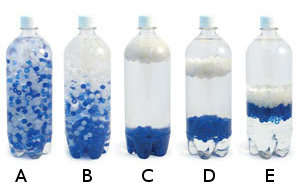 by: Tami O’Connor
by: Tami O’Connor
So, do you ever bring discrepant events into your classroom to capture your students’ attention? If so, the Poly Density Bottle should be on your list of must-haves! As you can see, this is a one-liter bottle filled with clear liquid. Floating at mid-bottle are two bands of beads, with blue on top of the white.

On its own, this is intriguing to many students. The head scratching begins, however, once the bottle is given a good shake. As soon as everything starts to settle, students will observe that the white beads now float at the top of the liquid while the blue beads sink to the bottom. The liquid, once clear, now appears to be slightly cloudy.
But wait, there’s more… After about 30 seconds something interesting begins to happen. The white beads gradually sink down, the blue beads gradually begin to float up, and the liquid above and below the beads is again clear. Now the stumper… Why is this happening?
I have taken this product to plenty of science conventions, and teachers across the country are equally baffled. At the last AAPT convention I attended, we had a physics lab professor from an Ivy League university visit our booth at least four times over the two day show. He struggled to try to figure out how this bottle worked. Given that his education was superior to mine, I gave him no hints! Figuring out the beads was simple. Two different colors, two different densities, but what made them float in the middle of the bottle when the liquid was settled, but separate when the bottle was shaken? During his final visit he concluded that there must be two different colorless liquids, rather than one.
That’s the heart of the answer. The question is, which two liquids are clear and colorless and have different densities, but are not soluble (don’t mix)? One of the liquids is isopropanol (rubbing alcohol) and the other is salt water.
Watch the Poly Density Bottle in action!
For upper grade students, here’s the chemistry explanation. Water and isopropanol are soluble in all proportions; they are miscible. Both the water molecules and the alcohol molecules have -OH groups that easily hydrogen bond to each other. The sodium chloride salt particles, Na1+ and Cl1-, however, preferentially bind with the water molecules forcing the alcohol molecules out of the water solution. This causes two layers to form: alcohol on top and the more dense water and salt layer on the bottom. Isopropanol and salt water are immiscible; they do not mix in all proportions. This ‘salting out’ technique is commonly used to remove organic molecules from an aqueous solution.
When the bottle is shaken, the two liquid layers briefly mix, forming a pseudo homogenous mixture with a combined density that falls between the two separate liquid densities. The white beads with a lesser density than this liquid mixture float on top, and the blue beads with a greater density sink to the bottom. Then, as the aqueous salt layer separates from the alcohol, the blue beads rise in the bottom aqueous layer and the white beads sink in the top alcohol layer until they meet in the center. From lowest density to highest density, the order is as follows: isopropanol, white beads, blue beads, and salt water. Because the beads float between the two liquids, the actual alcohol/salt water interface is difficult to observe, adding to the mystery. Order spontaneously forming from disorder is unexpected and gives the illusion of a violation of the Second Law of Thermodynamics.
For those of you with younger students, the explanation can be quite simple. There are two liquids that do not mix, like oil and water. When you shake them, they mix for a while (think Italian dressing…), and then eventually separate out again. Even students who have not yet been exposed to the term density, certainly understand floating and sinking. They will understand which items in the bottle are heaviest and which are lightest.
Though I tend to cycle through many of my hands-on manipulatives for my science table, the Poly Density Bottle was there all year long, and it was the one the students enjoyed most!
This device is great! It really gets the kids involved and thinking. They are initially stumped and/or come up with some incorrect explanations. It takes a few minutes of observations and questions, but they do eventually understand why the sequence of events happens. I have been using the same bottle for a few years. The liquid mixture has become a bit cloudy. Any fix other than emptying and re-doing? Thanks!
Hey Kendra, thanks for your comment! The easiest way to clear up the cloudy mixture is to refill the bottle. If you need the measurements of salt, water, and alcohol, please call us at 203-229-0730 or email at info@teachersource.com.
I understand that the white and blue beads are different density, but where can the be obtained or what specific densities are they so that the students could build and measure the process to develop hypotheses.
The observation is great, but having the separate elements available for measurement is tantamount to learning through questioning.
Hi Mark,
We may consider putting a kit together so students can build their own density columns. We have thought about it for a while now, so perhaps it’s time for us to move forward on the idea.
I would like to purchase the different blue and white beads with different densities.
Hi Tami,
You can purchase this kit on our website, http://www.teachersource.com.
i purchased the bottle but I’m not sure what is the liquid that i need to add to the mixture.
Hello Sara,
All the instructions and materials were included with your kit. If you can’t find it, please call customer service, and we will confirm your purchase and give you whatever you need.
Tami
Educational Innovations